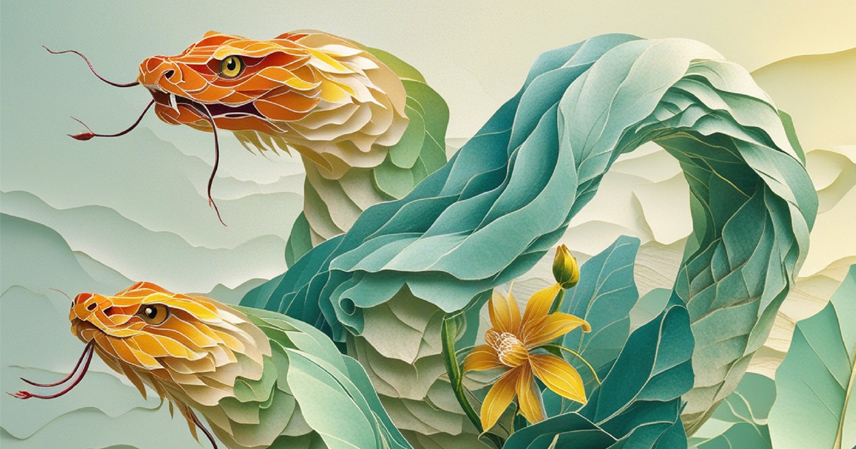The Enduring Allure of Snake Mythology
Since the dawn of civilization, snake mythology has captivated human imagination across continents. Whether whispered through ancient Chinese legends or retold in Western religious tales, the serpent remains one of the most complex and paradoxical creatures in world mythology. In the East, snakes are often associated with wisdom, fertility, and divine power. In contrast, Western mythology frequently casts the serpent as a deceiver — a symbol of temptation, sin, and chaos.
This divergence reflects how different societies project their values, fears, and desires onto the same creature. Yet beneath these contrasts lie striking similarities, revealing humanity’s shared fascination with transformation, mortality, and the mystery of life itself.
Snakes in Chinese Mythology: From Creation to Deification
In Chinese mythology, snakes are deeply intertwined with creation and divine ancestry. Ancient texts describe the primordial beings Pangu, Fuxi, and Nüwa, whose bodies combined human and serpent forms — a testament to early Chinese reverence for the snake’s power and fluidity.
According to Shan Hai Jing (“The Classic of Mountains and Seas”), Nüwa, the goddess credited with creating humanity and repairing the sky, had the head of a woman and the body of a serpent. She could transform seventy times a day — a metaphor for life’s endless renewal. Similarly, her consort Fuxi, often depicted with a human face and serpent tail, was believed to have taught humans how to hunt, fish, and write. Together, they embody the dual forces of creation and fertility.
Among China’s ethnic minorities, serpentine ancestors also appear in origin myths. The Nu people, for instance, tell of bees and snakes uniting to give birth to their matriarch, symbolizing the union between nature and humanity. Across regions and centuries, the snake’s divine connection reflects the ancient Chinese belief that life’s essence flows from the cyclical and the mysterious.
From Serpent to Dragon: Evolution of a Symbol
Many scholars argue that the Chinese dragon — the ultimate emblem of imperial power — evolved directly from ancient snake totems. By merging serpentine grace with features of other animals like deer horns and fish scales, early tribes elevated the snake into a composite symbol of prosperity and protection.
Even today, snakes are affectionately called “little dragons” in some regions. When snakes shed their skin, it is believed they are reborn — a transformation mirrored in the “Dragon Raises Its Head” festival on the second day of the second lunar month, marking the end of winter and the return of vitality. This continuity between snake and dragon reinforces the idea of renewal and upward ascension, linking natural cycles to cosmic order.
The Dual Nature of the Serpent in Chinese Belief
Despite its divine associations, the snake’s image in China is not entirely benevolent. Over time, Buddhist influences reshaped popular perceptions, introducing the notion of the snake as a symbol of anger, poison, and karmic suffering.
In Buddhist scriptures such as the Ekottara Āgama, snakes embody the four poisons of human existence, representing destructive emotions that bind people to suffering. This imagery appears vividly in the legend of Empress Chi, wife of Emperor Wu of Liang. Overwhelmed by jealousy, she was said to have transformed into a massive, tormented serpent after death — a parable about moral retribution and spiritual redemption. The emperor, stricken by guilt, commissioned the Book of Repentance at the Compassionate Altar (Liang Huang Bao Chan), hoping to release her soul from torment.
These stories reveal a fascinating blend of Daoist, Buddhist, and folk beliefs: the snake as both divine and damned, a mirror of the human struggle between virtue and desire.
Western Mythology: The Serpent as Temptation and Evil
In stark contrast, Western mythology casts the serpent in a more sinister role. The most influential example appears in the Book of Genesis, where Satan takes the form of a serpent to tempt Eve into eating the forbidden fruit. This act introduces sin into the world, forever linking snakes to deceit, sexuality, and the fall of humankind.
Other fables reinforced this dark portrayal. In Aesop’s fable “The Farmer and the Snake,” the creature repays kindness with treachery, epitomizing ingratitude and moral corruption. Greek mythology, too, abounds with serpentine antagonists — from Medusa’s snake-covered hair to Hera’s serpents sent to kill infant Heracles. Snakes became shorthand for evil, chaos, and uncontrollable passion, while their predators — eagles, storks, and hawks — symbolized divine justice and purity.
This moral polarization helped shape Christian and Western attitudes toward nature and the body, contrasting with Eastern traditions that often view the same creature as a sacred force of transformation.
Shared Symbolism: Fertility, Rebirth, and Healing
Despite their opposing moral tones, both traditions converge on several symbolic ideas. Chief among them is the snake’s association with fertility and regeneration. Because snakes shed their skin, they naturally became metaphors for renewal, longevity, and immortality — themes that transcend cultural boundaries.
In Western medicine, the serpent takes on yet another form: a healer. The image of a snake coiled around a staff — the Rod of Asclepius — originates from Greek mythology, where the god Asclepius used serpents as symbols of rejuvenation and medical wisdom. Today, this emblem endures as a universal icon of healthcare.
Similarly, in Chinese folklore, the snake’s cyclical rebirth is celebrated as a sign of resilience and prosperity. The beloved legend of Madam White Snake, where a serpent transforms into a woman to repay a man’s kindness, embodies compassion, love, and transcendence — virtues often overlooked in Western tales.
Desire, Fear, and the Human Condition
The serpent’s enduring power across civilizations reveals more about humanity than the creature itself. In both East and West, snakes occupy the boundary between good and evil, life and death, body and spirit. They seduce, heal, punish, and enlighten — reflecting the contradictions within human nature.
As Sun Yat-sen once wrote, humanity evolves by overcoming its beastly instincts and embracing divine reason. The serpent, forever suspended between these two realms, continues to remind us that enlightenment often slithers through the shadows of desire.
References
- Shan Hai Jing (The Classic of Mountains and Seas)
- Book of Genesis, The Holy Bible
- Aesop’s Fables
- Liang Huang Bao Chan (Book of Repentance at the Compassionate Altar)



